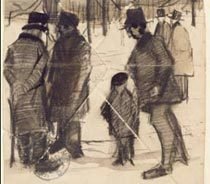Vincent van Gogh
dal 10/1/2008 al 29/3/2008
Segnalato da
10/1/2008
Vincent van Gogh
Van Gogh Museum, Amsterdam
The artist drew and painted constantly, utilizing every available scrap of paper for rapid scribbles or more detailed drawings and notes. Sketches and scribbles by him have been found on envelopes, the flyleaves of sketchbooks and on pieces of cardboard. Also on show is one of Van Gogh's sketchbooks and several letters containing sketches that he sent to his brother Theo and others.

From 11 January through 30 March 2008, the presentation Van Gogh’s scribbles will be on show in the Van Gogh Museum’s print room. Vincent van Gogh (1853-1890) drew and painted constantly, utilizing every available scrap of paper for rapid scribbles or more detailed drawings and notes. Sketches and scribbles by him have been found on envelopes, the flyleaves of sketchbooks and on pieces of cardboard. This presentation brings such drawings together for the first time -- some have never before been shown to the public. Also on show is one of Van Gogh’s sketchbooks and several letters containing sketches – or ‘scribbles’ as he termed them – that Van Gogh sent to his brother Theo and others. These scribbles served to show the letter’s recipient the kind of works Van Gogh was busy with, or to illustrate the materials he was using.
Drawings and sketches are seldom shown to the public because of their sensitivity to light. This presentation offers a unique opportunity to discover this lesser-known side of Van Gogh’s work.
A fine example of a sketch in an unusual place is the Big wheel Van Gogh drew on the reverse of his painting Small bottle with peonies and blue delphiniums executed in 1886. He painted the still-life on painter’s board, a cheaper material than canvas. In fluid pencil strokes on the reverse he sketched a cheery scene depicting people on a big wheel. The presentation shows the painting from both sides.
Van Gogh was an enthusiastic collector of prints. During his time in The Hague (1881-1883) he purchased large numbers of magazines, from which he cut out the illustrations and pasted them on paper in order to be able to file them according to subject or artist. Now and then he would paste such illustrations on the reverse of his own drawings. But the opposite was also the case: sometimes he’d use the reverse of the sheet on which he had pasted an illustration to make a quick sketch. Several of these remarkable leaves are displayed here for the first time.
Paper cost money, and therefore Van Gogh had to use his sheets of drawing paper to the full. That becomes apparent from the sketches he executed on sheets of paper he had already used for drawings. He separated the sketches from the main subject by surrounding them with a border. An example is the big drawing of an interior with tables and chairs he executed during the last months of his life in Auvers-sur-Oise. On a small part of the sheet of paper as yet unused he executed a diminutive sketch after his painting The bedroom. This was a canvas he’d painted a year and a half earlier, but he’d just seen it again during a visit to his brother Theo in Paris.
The presentation Van Gogh’s scribbles also devotes attention to the ‘scribbles’ Van Gogh made in his letters. These sketches had no aesthetic function and served but a single purpose: to give Theo or other correspondents an idea of what a painting or drawing looked like that he was working on or had completed. Such scribbles are however of inestimable value in contributing to our knowledge of the way in which Van Gogh worked. That is particularly true of the sketches he made in order to explain his use of materials and technique, or the circumstances within which he worked. These drawings vary from situational sketches of his studio and the shutters he used to regulate the light fall, to the construction of his frame of perspective and descriptions of the colours on his palette and the broadness of his brushes.
Van Gogh Museum
Paulus Potterstraat, 7 - Amsterdam



